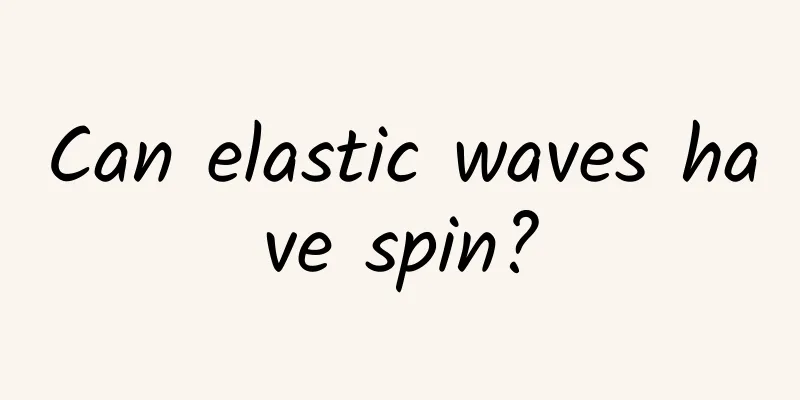Can elastic waves have spin?

|
Spin is one of the core concepts in physics, and its research has opened up a wonderful quantum world for us. Interestingly, spin angular momentum exists not only in quantum systems, but also in classical wave systems. For a long time, people have believed that only circularly polarized transverse waves (such as electromagnetic waves) have spin, because elastic longitudinal waves (such as sound waves in fluids) do not have polarization perpendicular to the propagation direction. Is this really the case? This article will introduce the exploration of elastic wave spin. Written by | Young 1 Introduction: Starting from angular momentum I believe everyone has played with a spinning top and knows the fun of it: the faster it rotates, the harder it is to fall. When it falls, it does not fall directly under the action of gravity, but continues to rotate crookedly. This is because the faster the spinning top rotates, the greater its angular momentum along the axis of rotation, and the more difficult it is to change the direction of the spinning axis. These properties of the spinning top can be summarized by a law: conservation of angular momentum. Today, angular velocity sensors named after gyroscopes have been widely used in various scenarios; whether it is mass consumer goods - mobile phones, or the forefront of human exploration - satellites, they all rely on gyroscopes to sense posture and direction. Although their structures are very different from toy gyroscopes, their core functions are still achieved by using the basic physical law of conservation of angular momentum. It can be said that research related to angular momentum is an indispensable part of basic research and technological development. In the study of various physical systems, the angular momentum-related properties of waves have also attracted much attention. For example, in electromagnetic waves, there is "spin" angular momentum determined by the polarization characteristics of the electromagnetic field and "orbital" angular momentum determined by the spatial distribution of the phase. Reasonable characterization and manipulation of the angular momentum of electromagnetic waves can help people improve communication channels and bandwidth. Similarly, in the study of air sound waves, orbital angular momentum can also be used to improve the channels and bandwidth of sound wave communication, and to manipulate the rotation of particles. Compared with electromagnetic waves, people pay more attention to the "orbital" angular momentum of sound waves. Because air is a fluid, and there is no shear force in an ideal fluid, in general, this indicates that the velocity field of air sound waves has no curl. Therefore, air sound waves do not have polarization behavior perpendicular to the propagation direction similar to electromagnetic waves; "sound waves have no spin angular momentum" derived from "sound waves have no rotation" has always been a consensus. However, can no curl and no spin angular momentum really be equated? We know that sound waves actually describe the elastic vibration of the medium. In a broad sense, sound waves include not only sound waves in fluid media such as air, but also sound waves in solid media. We can collectively refer to them as elastic waves. In order to more systematically explore the question of "Does air sound have spin angular momentum?", let's first look at the angular momentum of elastic waves. 2 Angular momentum in elastic waves Before we start to explore the angular momentum carried by elastic waves, we need to clarify two issues: 1. Is the “spin” we are discussing the spin in quantum mechanics? For macroscopic systems, the study of wave spin does not require knowledge of quantum mechanics. Take electromagnetic waves as an example. In quantum optics, the spin angular momentum of electromagnetic waves is actually the spin of photons. However, when studying electromagnetic waves from a macroscopic perspective, without entering the realm of quantum effects, the circularly polarized classical electromagnetic field can have spin angular momentum. (ii) Since the quantized description of electromagnetic waves is photons, what is the quantized description of elastic waves? Does it have spin? The quantized description of elastic waves is "phonons" [1], and the spins of elastic waves and phonons can also be linked through the quantized description of fields [2]. Although phonon spins were studied as early as 1961, previous research focused more on "transverse wave" phonons (i.e., circularly polarized modes of shear vibrations) and did not answer whether "longitudinal waves" with zero curl have spin angular momentum. The following discussion in this article is still mainly based on the classic perspective. In classical mechanics, the angular momentum L of a particle with respect to a fixed point O is defined as: Among them, r is the position vector pointing from point O to the particle, p is the momentum of the particle (i.e., the product of the mass of the particle and the velocity of the particle), and x represents the cross product of the vectors. If the elastic medium is regarded as a collection of a series of particles, then the elastic wave is the vibration of these particles (as shown in Figure 1). The angular momentum carried by these particles relative to a fixed point O during vibration is the angular momentum carried by the elastic wave. Figure 1 Elastic waves can be viewed as a series of vibrations of particles. It is worth noting that the continuous medium that carries elastic waves, which is often discussed, has positional relationship requirements between its mass elements, which is different from freely moving particles. Fig. 2 Binary star system. For example, two free particles can perform the binary motion shown in Figure 2. But for elastic waves, any two mass elements in the medium are more like two points on a piece of cloth. Under the premise of ensuring that the cloth is not torn and does not move as a whole, these two mass elements cannot perform a two-person turn like the binary system above. Therefore, elastic waves are more suitable to be described by a continuous "field" than discrete particles. When there is no elastic wave propagation, we assume that the position vector of the mass element relative to the origin of the coordinate system is r; when there is an elastic wave, the position of the mass element is u(t)+r, where u is the vector representing the deviation of the mass element from the equilibrium position, which is a function related to time. In this way, we obtain a vector field that can characterize elastic waves and is related to time: u(r, t), which means that a displacement vector u is obtained at each equilibrium position r. The equilibrium position r is independent of time, and the "cloth" will not move as a whole; and we require that the derivative of this vector field exists and is continuous, which ensures that the "cloth" is always smooth and will not be torn. Therefore, we might as well replace the particle diagram with a diagram of the vector field u(t)+r, with the starting point of the arrow at r, the direction of the arrow representing the direction of u, and the size of the arrow representing |u|. Taking the solid acoustic surface wave - Rayleigh wave in Figure 3 as an example, the vibration of a collection of particles can be described by a vector field that changes with time. Fig. 3 Rayleigh waves in a solid; the left image is a particle image, and the right image is a displacement field image. So, how should we discuss the angular momentum of this field? Let us follow Lord Bull's advice and stand on the shoulders of giants. Let's welcome Emmy Noether, a giant in mathematics and physics. (Editor's note: See "A mathematician admired by the gods of mathematics, whose theorems became the cornerstone of 20th century physics.") Emmy Noether (1882-1935) She told us that any differential symmetry of the action of a physical system has a corresponding conservation law. Simply put, if we translate, rotate, or even twist the coordinate system of a physical system, while keeping its action the same, we can find the corresponding conservation law. For example, time translation symmetry corresponds to energy conservation, space translation symmetry corresponds to momentum conservation, and space rotation symmetry corresponds to angular momentum conservation. For elastic waves, we only need to write out its Lagrangian, give it a variable, and rotate it to get the form of the elastic wave's angular momentum. As for how to separate orbits and spins in rotation operations, we can start from the language of "operators" and rotation matrices (note that this does not mean that we need to consider quantum effects to describe elastic wave spins), and give a "lazy" way of understanding that is commonly used in textbooks. When making infinitesimal rotations on a vector field, the rotation can be understood as two parts: rotation of the coordinate system, marked with a blue line in Figure 4; rotation of the vector itself, marked with a red line in Figure 4. The former can obtain the "orbit" part, and the latter can obtain the "spin" part. We can see the difference between "orbit" and "spin": the former is related to the overall distribution in space. The difference between orbital angular momentum and spin angular momentum is not very intuitive to explain by whether there is r in the expression. To make the difference between the two more clear, we can imagine a very thin elastic ring and assume that the ring vibrates with only orbital angular momentum density/spin angular momentum density to see what the corresponding vibration mode is. As shown in Figure 5, the black ring represents the equilibrium position of the ring, and a series of black arrows representing u are drawn from this circle as the starting point. Figure 5. The displacement field (black arrow) changes with time when there is only orbital angular momentum density (OAM). It can be seen that the displacement field at each position does not change direction, but the vibration mode is rotating as a whole. At this time, the vibration state of the entire ring is "circling", but each black arrow has not changed direction, but only changed size. This means that the movement of the mass element is always "straight forward and backward". If you observe the vibration of a fixed position on the ring alone, you can find that the mass element itself is not spinning, that is, the spin angular momentum density is zero (each mass element itself does not have circularly polarized vibration), but the orbital angular momentum density is not zero - the vibration state (or energy flow) of the mass element is propagating in the counterclockwise direction. So, if the vibration mode on the ring does not propagate along the ring, is there no orbital angular momentum? Yes, like the ring shown in Figure 6, its overall orbital angular momentum is zero. Figure 6. Time-dependent variation of displacement field when only spin angular momentum density (SAM) is present. It can be seen that the vibration mode as a whole does not rotate, but the displacement field at each fixed position does rotate. Obviously, the vibration state of the ring does not propagate clockwise or counterclockwise along the ring at this time, but the black vector representing the displacement of the mass element is rotating, that is, these mass elements carry angular momentum. Therefore, the orbital angular momentum density of this ring is zero, but the spin angular momentum density is non-zero. It is worth noting that from the above analysis we can also see that the spin of the field (wave) is the rotation of the field polarization vector (such as displacement, velocity) over time, and has nothing to do with the spatial vortex of the field vector. Therefore, even in a fluid that can only propagate pure longitudinal waves (whose displacement field curl is zero), such as air sound waves, it is possible to carry spin angular momentum [3, 4]. At this point, we can finally say that "sound waves are irrotational" does not lead to "sound waves have no spin angular momentum". 3 Why are elastic waves so unique? The contribution of hybridized spins Through the previous discussion, we have roughly understood what the spin angular momentum of elastic waves is, and also answered the question of whether an irrotational field can have spin angular momentum. The next step is to think about what interesting properties the spin of elastic waves has. The red part of the above equation is the transverse-longitudinal cross term that does not appear in pure transverse waves or pure longitudinal waves. We can call it the "hybrid" contribution to the elastic wave spin angular momentum. The existence of "hybrid" spins will lead to a richer structure of elastic wave spins. For example, in the surface wave system, the spin distribution of elastic waves appears "unique" [5]. Figures 7 ad correspond to surface water waves, surface electromagnetic waves, surface air acoustic waves, and Rayleigh waves, respectively. The blue color of the color map indicates that the direction of the spin angular momentum density is perpendicular to the paper surface and inward (negative), and the red color represents the direction perpendicular to the paper surface and outward (positive); the black arrow represents the magnitude and direction of the vector field, and the corresponding elliptical polarization direction is drawn on the right. Obviously, the elastic surface wave on the far right has a significant difference in spin distribution from the first three systems. The vector fields of the several surface waves shown in Figure 7 are mathematically very similar [5], and their amplitudes decay exponentially with increasing depth. Although the curl and divergence (geometric properties in the spatial domain) of the first three fields are different, their spin densities (rotational properties in the time domain) are similar, all of which are perpendicular to the paper and inward, and their size gradually decreases with increasing depth. Elastic surface waves (i.e., Rayleigh waves) are different. Not only is the spin direction perpendicular to the paper and outward on the surface of the elastic medium, but the spin direction also flips with increasing depth. This is actually due to the existence of "hybrid" spins, which makes elastic waves different from other systems. Nowadays, the classical theory of elastic waves has been widely used in various fields. From engineering applications such as earthquake research, geological exploration, non-destructive testing, surface acoustic wave filters, to cutting-edge exploration based on elastic metamaterials, light-elastic, and magneto-elastic coupling systems, elastic waves need to be regulated. Combining the mature elastic wave related theory and starting from the new perspective of "elastic spin", some new ideas can be provided for practical applications. The characteristics brought by "hybridization" can also inspire some unique control methods of elastic waves. For example, in ultrasonic testing, the excitation and identification of guided wave modes are critical. Different guided wave modes have different response characteristics to defects, and it is very important to selectively excite pure guided wave modes. Here we take Lamb waves, a basic type of elastic waveguide, as an example to compare Lamb waves with similar guided waves in other systems to see what the differences are in their spin distributions. In a two-dimensional waveguide, according to the symmetry of the vibration modes on the upper and lower boundaries of the waveguide, the waveguide can be divided into two types: symmetric mode and anti-symmetric mode. Figure 8 Symmetric and antisymmetric modes of electromagnetic waves. The black arrows indicate the electric field. Here, the directions of the spin densities on the upper and lower surfaces are the same for the symmetric and antisymmetric modes. Figure 9 Symmetric and antisymmetric modes of airborne sound waves. The black arrows indicate the velocity field. Here, the directions of the spin densities on the upper and lower surfaces of the symmetric and antisymmetric modes are the same. Figure 10 Symmetric and antisymmetric modes of elastic plate waves (Lamb waves). The black arrows indicate the displacement field. It can be seen that, unlike the guided wave modes of electromagnetic waves and air acoustic waves, the directions of the spin density on the upper and lower surfaces of the symmetric and antisymmetric modes of Lamb waves are opposite. From Figures 8-10, we can see that only the symmetric/antisymmetric mode (S/A mode) of elastic waves presents opposite spin angular momentum distribution. Through calculation (Figure 11), it can be seen that the difference between the S mode and the A mode is determined by the contribution of the "hybridization" part. Figure 11 In the A0 and S0 modes of elastic plate waves (Lamb waves), the hybridization contributions (Sh) are opposite, resulting in opposite total spins. Generally speaking, if you want to control the symmetry of the wave on two boundaries, you need to install an excitation source on each boundary, that is, at least two excitation sources in different positions. However, the distribution of elastic spins in the A0 and S0 modes of Lamb waves is opposite. This means that we only need to install a circularly polarized source (chiral source) on one boundary to control the direction of the elastic spin near the boundary, and then excite the symmetric and antisymmetric modes respectively. Figure 12. A/S modes are excited in opposite directions using a spin source on a single boundary. A set of mutually perpendicular piezoelectric plates can control the polarization mode in their vicinity, exciting a characteristic elastic spin signal. Figure 12 shows a way to realize the chiral source: use a set of mutually perpendicular piezoelectric plates to control the vibration phase difference in two perpendicular directions, so that the spin direction of the vibration excited by the chiral source can be freely controlled. If the spin source excites the spin-positive mode at the lower boundary of the thin plate as shown in Figure 12, then we can observe the A0 mode on the left side of the source (x<0) and the S0 mode on the right side of the source (x>0). In experimental measurements, the frequency domain signal can be obtained by scanning the field and performing a two-dimensional Fourier transform on the data. By comparing the measured results with the theoretical A0/S0 dispersion, it is possible to distinguish which mode is measured (Figure 13). Figure 13: Experimental measurement results, the signal is excited by a chiral source with S>0. On the left side of the source (x<0), the signal of the elastic wave is on the dispersion curve of the A0 mode, indicating that the signal is the A0 mode; the signal on the right side of the source (x>0) is the S0 mode. This shows that the experimental measurement results are consistent with the expectations in Figure 12. 4 Conclusion In general, from the perspective of classical waves, elastic waves can carry spin angular momentum. We can use the displacement field and Noether's theorem to strictly define the form of the spin angular momentum of elastic waves. In particular, the existence of spin angular momentum does not depend on whether the displacement field has curl, and the elastic wave displacement field also contains components with zero curl/divergence, which gives it a richer spin angular momentum structure. The new perspective of "spin" can be combined with the classical and mature theory of elastic waves to provide new ideas for the study of elastic waves. In addition, the above discussion does not involve much about the quantized version of elastic waves, "phonons". As the elementary excitations of the elastic wave field, phonons are regarded as a quasi-particle corresponding to lattice vibrations through the quantization process. In the reciprocal space, the intrinsic properties of phonons are closely related to the overall properties of elastic waves in real space, similar to the relationship between electromagnetic waves and photons. Therefore, phonon spin and elastic wave spin are two sides of the same coin and are closely related [2]. Considering the basic law of conservation of angular momentum, elastic wave spin and phonon spin can also be converted into photon spin, electron spin, etc. When it comes to processes such as electro-acoustic coupling, opto-mechanical coupling, magneto-elastic coupling and piezoelectric coupling, the introduction of elastic wave spin and phonon spin can help us better explore spin-related sensing and control technologies. Research related to angular momentum is an indispensable part of basic research and technological development. We hope that as our understanding of elastic wave angular momentum deepens, more and more interesting, novel and practical content will be discovered. References [1] Physics 51, 855 (2022) http://www.wuli.ac.cn/article/doi/10.7693/wl20221205 [2] Chinese Physics Letters 39, 126301 (2022) https://iopscience.iop.org/article/10.1088/0256-307X/39/12/126301 [3] Proc. Natl. Acad. Sci. 115, 9951 (2018) https://www.pnas.org/doi/abs/10.1073/pnas.1808534115 [4] National Science Review 6, 707(2019) https://academic.oup.com/nsr/article/6/4/707/5488454 [5] Phys. Rev. Lett. 131, 136102 (2023) https://journals.aps.org/prl/abstract/10.1103/PhysRevLett.131.136102 This article is supported by the Science Popularization China Starry Sky Project Produced by: China Association for Science and Technology Department of Science Popularization Producer: China Science and Technology Press Co., Ltd., Beijing Zhongke Xinghe Culture Media Co., Ltd. Special Tips 1. Go to the "Featured Column" at the bottom of the menu of the "Fanpu" WeChat public account to read a series of popular science articles on different topics. 2. Fanpu provides a function to search articles by month. Follow the official account and reply with the four-digit year + month, such as "1903", to get the article index for March 2019, and so on. Copyright statement: Personal forwarding is welcome. Any form of media or organization is not allowed to reprint or excerpt without authorization. For reprint authorization, please contact the backstage of the "Fanpu" WeChat public account. |
>>: Will you still have to go to work on New Year’s Eve in the next five years?
Recommend
Unlock the creative advertising secrets that make your brand popular and popular!
This article begins with a study of cases with ex...
A three-year-old child bit off a thermometer and swallowed mercury. You would never guess the correct way to deal with it!
A three-year-old kid in Zhumadian bit a thermomet...
When the iPhone is no longer magical, frequent personnel changes reveal Apple's difficult choices
Without waiting for too much speculation from the...
The three core techniques for private domain traffic operations!
I read two books before the Chinese New Year, bot...
Pepper: a “cultural and military” species
A former luxury spice While preparing dinner, you...
Scientists' new discovery: The bigger the dinosaurs, the lower their intelligence?
Recently, the research team led by Han Fenglu, as...
Uncover the 6 core skills of "social marketing"
If there is any low-cost and high-conversion oper...
Glass-integrated fingerprint recognition makes buttonless iPhone possible
Foreign media Apple Insider reported last month t...
The most important weapon of the country, fighting for the sea
recently The world's first 16MW offshore wind...
Three ways and strategies of bringing goods to new media Douyin
5,000 orders of Shiseido red kidneys in 3 minutes...
How can the maternal and infant community APP products make good plans for the new year?
This task is usually led by the product director ...
What problems does the monthly card function launched by ofo solve?
Currently, there are three entrances to ofo’s bik...
The operation logic of Douyin Enterprise Account!
From the internet-famous Haidilao dipping sauce, ...
Do you think plants don’t feel “pain” when you pick flowers and step on grass?
A news report said that scientists at Washington ...
Goddess crash course: How to build your attractiveness? 12 series of lessons to teach you step by step
A beautiful appearance but a boring soul can only...









